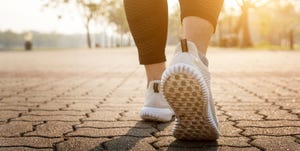Try This Hydration Formula If You’re Exhausted All The Time

I’m not going to sugar-coat it: The best way to get through your entire day without your eyelids drooping is to get enough sleep at night.
Seriously: “Nothing replaces sleep to give you energy,” says Alison Kole, M.D., director of sleep services at Summit Medical Group. “Most people require seven to nine hours of sleep per night to feel their best.”
Still, that’s not always entirely possible (just one more episode of The Great British Baking Show can’t hurt, right?). But the good news is there are some quick energy-boosting tips you can try that work pretty well in the moment. Here’s how to get more energy, like, right now.
1. Follow this super-specific hydration formula.
Admit it: You don’t drink as much water as you could—and dehydration is one of the main reasons why energy levels bottom out.
“Most of us walk around in a state of dehydration on a daily basis, and when your body is dehydrated it can make you feel tired and sluggish,” says registered dietitian and nutritionist Allison Childress, Ph.D.

Fortunately, Childress also says that pretty much any kind of beverage (except alcohol) counts toward your daily intake, so if you’re not a huge fan of plain water, mix it up with juice, tea, or even broth from soup.
Not sure how much you need? Kole says it depends largely on your body size, and recommends multiplying your weight by 0.67 ounces to calculate what your daily goal should be (for example, if you weigh 140 pounds, you should aim for 94 ounces a day).
2. Choose coffee over energy drinks.
Yes, a quick jolt of liquid caffeine can definitely perk you up—but here’s the thing, not all caffeine is created equal.

“Stay away from energy drinks…they may give you a temporary boost, but these are stimulants and can set you up for a crash later on,” says Childress, since energy drinks often contain caffeine as well as a mix of other stimulants like guarana and yerba mate.
She says that eight to 12 ounces of coffee is a much better choice when you need some liquid energy (i.e., no crash). Just be mindful of the timing; Kole warns that having caffeine too late in the day (say, after 4 p.m.) can interfere with sleep—and possibly force you to need even more caffeine the next day.
3. Snack on both carbs and protein.
Your body’s energy comes from the calories you consume, says Childress, so if you’re feeling sluggish you might need to fuel up. But don’t head to the vending machine down the hall; there’s a simple formula for noshing on a perfectly energizing (and healthy) snack.
“Choose a carb and a protein for maximum punch,” she explains—the carbs will provide your body with fuel, while protein will help you stay fuller (and more satisfied) longer. “Try an apple with a piece of string cheese, a cracker with nut butter, or half of a protein bar,” says Childress.
4. Do a few laps at the office (or just get up for some water).
If you find yourself nodding off at your desk, there’s a simple solution: Take a walk—it’s an automatic source of energy that boosts your circulation and keeps your muscles active, says Kole.

And before you complain that there’s no place to walk outside your office building, know that fresh air is not mandatory for this tip to work. Take regular trips to the water cooler, log some laps around your department’s collection of cubicles, or walk up and down the stairs a few times. Childress suggests setting an alarm on your phone to remind yourself to get up from your desk every hour and move.
“Do it regularly to keep tiredness at bay and keep your mind focused—a move break is just as good for your mind as it is for your body,” she explains.
5. As soon as you wake up, make a plan to crush the day.
You know that feeling when you wake up and have so much to do that you kind of just want to go to bed? This tip can help with that “I’m so overwhelmed” feeling.
Kole suggests starting every day with a positive thought or goal (like, “I’m going to spend 20 minutes mentally rehearsing for my presentation over coffee today”). This will help you manage your attitude toward the day’s activities—and conserve some of your precious energy, because freaking out about everything is super draining. “Personally, I try to focus on one thing I’m thankful for,” she says, “which creates a positive mindset moving forward.”
6. Take a whiff of something refreshing.

Whether you work in an office or at home, the air around you can get…stale—which definitely doesn’t bode well for staying alert.
Perk up by diffusing essential oils (they’ll spice up your environment and boot your energy levels). Childress says that eucalyptus and citrus oils can refresh a tired body and mind, and that if simply smelling some zesty lemon doesn’t quite do the trick, you can also try putting a drop on some pressure points (like the insides of your wrists) for an extra kick. Just make sure to read the directions; some essential oils can irritate the skin.
7. Go outside on your lunch break.
Sunny days aren’t just good for your mood—they can also be good for your mental and physical health.
“The sun can be very invigorating [and it can also] stimulate vitamin D production, which has been shown to enhance mood,” says Childress. Everyone needs vitamin D for bone health, but many don’t get enough of it from food—enter, supplements and good ol’ fashioned sunshine.
FYI: a little bit of sunscreen-free sun exposure is okay, but make sure you don’t go overboard. You don’t need to tan or burn your skin in order to soak up those vitamin-rich rays; you only need about 10-15 minutes of exposure.
8. Keep your curtains open and wake up by daylight.
Pro tip: The ideal length for a power nap is about 20 minutes.
If you need one more reason to consider the sun your friend, pay attention: opening up your curtains and letting daylight into your bedroom as soon as you wake up in the morning can set you on an energized course for the whole day.
Kole says that exposing yourself to bright light first thing in the a.m. helps regulate your internal sleep-wake body clock and may even improve your mood, especially if you suffer from seasonal affective disorder (SAD).
9. Go ahead, take a (power) nap.
If you have a full-time job (or children), taking a nice, long restorative nap when you’re feeling sleepy is probably out of the question. But there’s good news: you don’t need a long nap to reap the benefits of some afternoon shut-eye.
“The ideal length for napping typically is about 20 minutes,” Kole says. “Longer naps tend to leave people sleepier, in part because the further you go into a sleep cycle the more likely you are to hit deep sleep, and waking up during that stage often causes people to feel groggier.” Basically, consider this permission to take a quick midday snooze.
10. Try to sweat a little bit before breakfast.
In addition to making you feel super-productive before even starting your day, working out in the morning can boost your energy, as well as control anxiety, and reduce stress—two major energy-suckers, says Kole.

But there’s one other reason to make going for a daily run the first thing on your daily to-do list: According to Kole, a morning workout sets a positive and energized tone for the rest of your day, while working out in the late afternoon or evening is more likely to interfere with your ability to fall asleep at night, she adds.
11. Free up brain power by actually writing things down.
If I were to peek into your brain right now, I’d likely see a miles-long list of appointments, schedule changes, and other things you definitely cannot forget about—and that’s a recipe for crushing fatigue, says Kole.

You actually expend a lot of energy trying to mentally keep track of everything you need to do, so Kole recommends sitting down to actually get some of that stuff done—or at least organizing yourself better by writing down all of those things. She says resolving these distracting loose ends can free up tons of brain power and make you feel more prepared to tackle the next thing on your list, whatever it is.
Need more inspo? It’s Transformations Week on WomensHealthMag.com! For more amazing beauty, fitness, and weight loss transformations, check out the rest of our Transformations Week collection.
Source: Read Full Article
